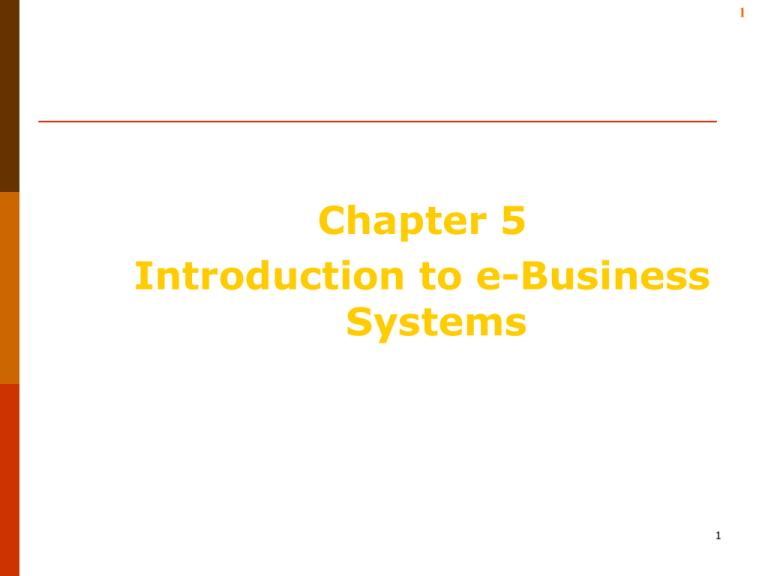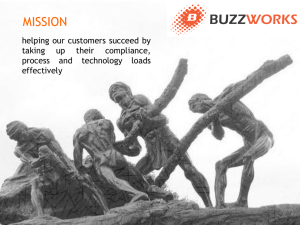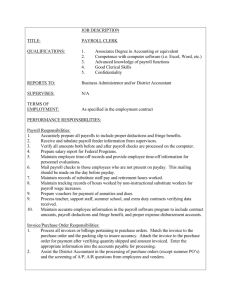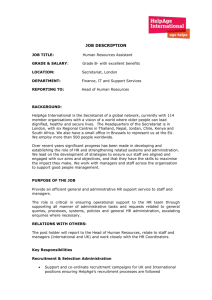O'Brien MIS, 6th ed.
advertisement

1 Chapter 5 Introduction to e-Business Systems 1 2 Learning Objectives Give examples of how Internet and other information technologies support business processes within the business functions of .. Accounting, Finance, Human resource management, Marketing, and Production and operations management. 2 3 Learning Objectives (continued) Identify the cross-functional enterprise system concept. 3 4 Functional Information Systems 1. 2. 3. 4. 5. ISs can be classified by the specific organizational functions. Marketing-Sales Manufacturing Human Resource Accounting Finance 4 Functional Areas in a Business 5 •Compensation •Vacation •Skills/Training Human Resources •A/R •A/P •Payroll •General Ledger Accounting •Receiving •Fulfillment •Process control •Purchasing •Cash Management •Asset Management •Budgeting Business Funtion Operations Financing •Order Taking •CRM •Self-service Sales Marketing •Retail Pricing •Sales Promotions •Sales Force Management. •Customer Loyalty •Interactive Marketing 5 6 Marketing Systems The Sales and Marketing Function is responsible for selling the organization's product or service. Marketing Information Systems are computerized systems that support major marketing activities such as promotion, advertising, sale of existing products in existing markets and the development of new products. 6 7 Marketing Systems (continued) Some of the marketing information systems: 1. Interactive Marketing Based on using information systems to attract customers in creating, purchasing and improving products or services (Web forms, e-mails, questionnaires, discussion groups). 7 8 Marketing Systems (continued) 2. Targeted marketing: Important tool in developing advertising and promotion strategies. Five targeting components Community: companies can customize their web advertising messages and promotion methods to appeal to people in specific communities. Ex: arts and crafts hobbyists, sporting fans. Context : advertising such as banners or pop-ups can be placed on various website pages, in addition to company’s website. Content : advertising appears only in web pages that are relevant to the content of a product or service. Demographic: marketing efforts can be aimed only at specific types of people: unmarried, middle income, and male college graduates. Online behavior: advertising and promotion efforts can be tailored to each visit to a site by an individual. 8 9 Marketing Systems (continued) IT can help companies create customer databases of both existing and potential customers. The Internet opens the door to a new advertising medium. Online advertising via e-mail and banners is growing rapidly. IT helps companies to expedite the ordering and fulfillment of customized products. 9 10 Manufacturing Systems The manufacturing function is responsible for actually producing the firm's goods and services. Manufacturing systems deal with the planning, development and maintenance of production facilities, the establishment of production goals, storage and availability of production materials and the scheduling of equipment facilities, materials, and labor required. Manufacturing Information Systems support these activities. 10 11 Manufacturing Systems (cont’d) A few of the IT supported manufacturing areas are: Computer-integrated manufacturing (CIM) Inventory management Project management Material requirements planning 11 12 Manufacturing Systems (continued) 1. Computer-Integrated Manufacturing (CIM)the automated version of the manufacturing process. The goal of CIM is to create flexible, agile manufacturing processes that efficiently produce products of the highest quality. Supports the concepts of flexible manufacturing systems, agile manufacturing, & total quality management. Computer-Aided Manufacturing (CAM)- Automates the production process. Computer-Aided Design (CAD)-Automates product and process design using computers and sophisticated graphics software. 12 13 Manufacturing Systems (continued) Ex: Designers use computers to make better basketballs, baseballs, and other sport equipment at Spalding Sports Worldwide. This company uses imaging software (CAD) to improve its product development process. Developers create, share, discuss and update product specifications online; they no longer send paper copies to offices around the world. They reduced development time from one and one-half years to a few months. 13 14 Manufacturing Systems (continued) 2. Inventory management: Determines how much inventory to keep. A large number of commercial inventory software packages to automate the application of the inventory models (when to order, how much to order, how to track the level of inventory for each item) are available at low cost. 14 15 Manufacturing Systems (continued) 3. Project management: Planning, directing, and controlling the project resources to meet the technical, cost, and time constraints of a project. Several IT tools are available to support and help manage projects. 4. Material Requirements Planning (MRP) is software that facilitates the plan for purchasing or producing parts, subassemblies, or materials in the case of interdependent items. 15 16 Human Resource Systems Human resource function is responsible for attracting, developing and maintaining the firm’s work force. Human resource information systems support Identifying potential employees Creating programs to develop employee’s talents and skills. Recruitment, selection, & hiring Job placement Training 16 17 Human Resources Systems Web-based systems have increased the popularity of human resources information systems which provide applications mainly related to acquiring, hiring, rewarding, developing, training, protecting and retaining human resources. Recruitment is finding employees, testing them, and deciding which ones to hire. The Web has enhanced the recruitment process. Human Resources Maintenance and Development Performance Evaluation Training and Human Resources Development Personnel Planning 17 18 Human Resource Systems (continued) HRM and the Internet Allows companies to process most common HRM applications over their intranets. Allows companies to provide around-the-clock services to their employees. Allows companies to disseminate valuable information faster. Allows employees to perform HRM tasks online. Help human resource managers plan and monitor employee recruitment, training, and development programs. 18 19 Human Resource Systems (continued) • Edify Corporation’s employee-service system allows users to access information available an employee portal and also via voice-recognition phone, kiosks, or faxes. The package offers intranet-based automation of company procedures, collective bargaining agreements, employees’ handbooks, phone directories, pay scales, job banks, benefits, and training. 19 20 Human Resource Systems (continued) Oracle Corporation conducts its flexible benefits enrollment program on its employee portal. The employees give the program high marks because they feel it is simple and fast. Employees do not have to wait for a rigid company-wide starting date, and forms do not get lost. Furthermore, employees can see the trade-offs between various benefits, since the system calculates the cost of each benefit. Oracle allows new hires to input benefits data online. Finally, Oracle created links from its portal pages to Fidelity Investments’ 401(k) pages, so employees can learn about funds and pension plans online as well as register for the plans. 20 21 Human Resource Systems (continued) • Aetna Health Plan’s directory of primary care physicians, hospitals, medical services, and health information is available on the employees portal around the clock. The company also offers insurance options online. • Apple Computers, Inc. conducts extensive education and development activities on its employee portal, including a remote management-training program. 21 22 Human Resource Systems (continued) Auto manufacturer DaimlerChrysler has an international workforce of 370,000 employees with manufacturing facilities in 37 countries. Recruiting for DaimlerChrysler is big business. The company used the eRecruit module of PeopleSoft’s HRM product to eliminate much of the paperwork and streamline its recruiting process. The software enables job applicant to fill out application forms and post and update their resumes online. Human resource professionals and managers hiring for specific positions can view and evaluate interview results. Not only the recruitment process become more efficient, but the company has also saved money and freed human resource professionals to do analytical work rather than paperwork. 22 23 Comparison of Traditional HR to E-HR Key HR process Traditional HR E-HR Recruitment and selection Paper resumes and paper postings Electronic Selection Positions filled in months Limited by geographical barriers Manual review of resumes Positions Compensation and benefits Time spent on paperwork Changes made by HR Time Training and development Standardized Flexible classroom training Development process is HR-driven resumes and Internet filled in weeks or days Unlimited access to global applications Electronic review spent on assessing market salaries Changes made by employees online online training Development process is employee- 23 driven 24 Accounting Systems The accounting function is responsible for maintaining and managing the firm’s financial records-receipts, payroll- to an account for the flow of funds in a firm. Accounting information systems support these activities. Record and report business transactions and other economic events. 24 25 Accounting Systems Many companies are using or developing network links to their trading partners through the use of the Internet and other networks for applications such as accounts receivable, accounts payable, general ledger, and payroll. Payroll systems receive and maintain data from employee time cards and other work records. Produces paychecks, reports for management and government. 25 26 Payroll TPS INPUT Payroll master file PROCESS Calculating pay Calculating cost of taxes etc. Payroll system Data elements in payroll master file Employee number Employee name Employee department Employee occupation Employee pay rate Earnings State tax OUTPUT Management reports Government documents Employee checks 26 27 Accounting Systems Accounts receivable systems keep records of amounts owed by customers from data generated by customer purchases and payments. Produce invoices to customers, provide managers with reports to help them control the amount of credit extended and collection of money owed. 27 28 Accounting Systems Accounts payable systems keep track of data concerning purchases from and payments to suppliers. Prepare checks in payment and produce cash management reports, help ensure prompt and accurate payment of suppliers to maintain good relationships, provide tight financial control over all cash activities. 28 29 Accounting Systems General ledger systems consolidate data from accounts receivable, accounts payable, payroll, and other accounting information systems. Produce the income statement and balance sheet of the firm at the end of each accounting period. 29 30 Financial Management Systems The finance function is responsible for managing the firm’s financial assets such as cash, stocks, bonds and other investments in order to maximize the return on these financial assets. 30 31 Financial Management Systems Major financial information systems include: cash management, investment management, financial forecasting and planning. Cash management systems collect information on all cash receipts within a company on a real-time. Produce daily, weekly, or monthly forecasts of cash receipts, allow businesses to deposit or invest excess funds more quickly. 31 32 Financial Management Systems Investment management is a difficult task. Many companies invest large amounts of money in stocks, bonds or real estate. Some of these investments have billion of dollars of assets. Portfolio of securities can be managed with the help of portfolio management software packages. Online management services are available from hundreds of online sources on the Internet such as NYSE, Bloomberg, Dow Jones, etc. 32 33 Financial Management Systems Capital budgeting involves evaluating the profitability and determining the optimum mix of capital projects. Several software packages are available to support capital budgeting. It makes easier to build complex budgets. Most spreadsheet packages include built-in-functions of financial models such as NPV (net present value), IRR (internal rate of return) so financial analysts can easily build capital budgeting evaluation applications. 33 34 Major Business Functions 34 35 Cross-functional Enterprise Applications • • • Enterprise systems allow companies to integrate information across operations on a company-wide basis rather than storing information in separate places. They provide a central repository common to all corporate users. The major enterprise applications are ERP, CRM and SCM. 35 Cross-functional Enterprise Information Systems 36 History Sales Analysis Profiling Bar Coding Accounting ERP SPARS CRM Receiving Point-of-Sale SCM Service Purchasing Inventory Control Payroll Installations Integration of Cross-Functional Information Systems tears down barriers between and among departments & corporate headquarters and reduces 36 duplication of effort.






